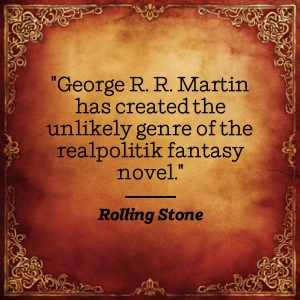Customer Services
Copyright © 2025 Desertcart Holdings Limited
Desert Online General Trading LLC
Dubai, United Arab Emirates


Full description not available



B**E
New Characters, New Places, New Horrors
I almost didn't buy this book because of the negative reviews and the litany of complaints about the quality of this book compared with the first three. I'm glad I wasn't swayed. True, some of the prominent characters from the first three books (who still survive) are missing, notably Tyrion and Daenerys as POV characters; but they are there in spirit and their (mis)deeds continue to influence the actions of the other main characters. With them missing, and a number of other characters killed off, who supplies the POV? Well, a number of new characters, sometimes only inhabiting one chapter; but unlike some reviewers I found that the new characters added a new dimension to the book, which together with the flashbacks to times long gone, added flesh to the bones of a rip-roaring adventure to make it a true classic.The landscape is as dark and dreary as before but with new horrors. Perhaps the most understated is Qyburn, who carries out unspeakable acts in the deep dungeons of Kings Landing - well, maybe not always unspeakable, as some of the torture scenes are described in horrible detail. As always decapitated heads, rotting flesh, maiming, disfigurement and cannibalism are well covered in the writing, brought into vivid contrast by descriptions of juicy oranges being enjoyed in Sunspear the capital of Dorne. Meanwhile we get an in depth look at the Ironborn people, with their fiercely proud but cruel code of conduct. This is typified by the idea that going to sea without wearing full armour is craven because it shows that you are afraid of drowning; a novel, but somewhat warped concept!One of the key elements in this book is the emphasis given to the different religions and their growing importance, which first became apparent in "A Clash of Kings" with the murder of Renly. Also, the divide between the living and dead is becoming blurred (Watch out for The Hangwoman!), possibly paving the way for fresh horrors from beyond the wall in the next books of the series.Apart from the price of the Kindle edition, the only other area in which I would agree with some of the negative reviews is the complexity of the plot and the vast number of characters, often with similar names. To make it even worse, a couple of the characters change their name, and in one case the new name is used as a POV character. To follow all of this you either have to have an excellently organised memory, or read the book in one mammoth session. Failing that, do as I did - cheat! The only way I can manage the books in this series is to read them with a concordance alongside. As I mentioned in a previous review I have found a couple of Apps for the iPhone which work well for me. Game of Thrones - Wiki (online) and Game of Thrones Companion (offline). By occasionally referring to one, or both of these, I can just about keep my head above water (no reference to the Ironborn intended) and enjoy this masterpiece.
R**E
Such high expectations, and this almost delivers!
Ok, I'm going to start with a very clear statement before I go about trying to sum up my slightly confused feelings about this book: it's a really, really good read. In the same vein as the previous four (five) books in this series, this novel is very readable, full of intrigue and long enough to keep you satisfied for a good while.However, my confusion arises (along with only four stars instead of five) because this is almost certainly the weekest of Martin's Song of Ice and Fire series so far. Why is that? Well, to be honest, it is because it feels like the plot (in the series as a whole) doesn't really move forward in this book. And why is that? Well, it's because the main characters - and by this I mean the real mainstays, the characters we have come to love over Martin's previous novels: the Stark children and Tyrion Lannister in particular - are barely mentioned. Indeed, even old Davos Seaworthy doesn't get more than a passing mention here.The action focusses almost solely on King's Landing, where the Lannister twins take centre stage (who would have thought in the first two novels that Jaime Lannister would be the character you looked forward to hear about, and hoped was ok!), on the Iron Isles, where the Greyjoys are deciding on their succession, and on Dorne, where a whole new kingdom and a third of this novel are apparently written about for the sake of one (albeit amazing) piece of information revealed in the final chapters.This means that those elements which seem key to the whole plot - Tyrion, the Starks and of course Danaerys Targaryen - are completely ignored. George Martin explains this at the end of the novel - he'd simply written too much, and decided to split the next two novels to give us the full story of some of the characters in each book. But the problem is - why did he leave all the plot and all the main characters in the second book? And why is the second book taking so long?However, as I started by saying, this book is lovely to read. The characters that are here are intriging and the stories told are interesting. But there are none of the gut-wrenching moments of previous books, there is a slight down-turn in the excitement and page-turnability of what we find here. So if you've read the previous elements of the series, then don't expect too much.If you haven't read any George Martin books before, then you definitely, *definitely* need to start at the beginning... And make sure you do start!
Trustpilot
2 weeks ago
2 weeks ago